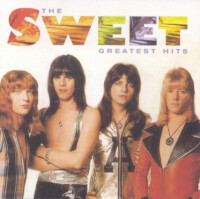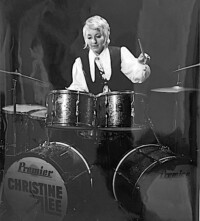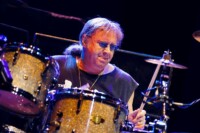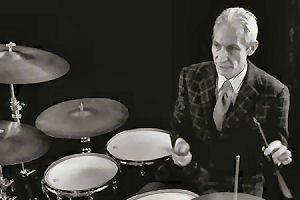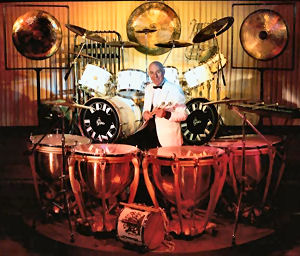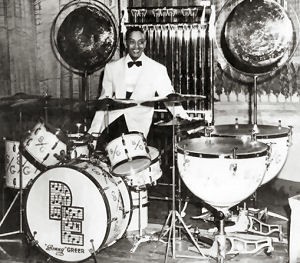 Sonny Greer was born in New Jersey on December 13th 1895 (there are other possible dates, but this would seem to be the most consistent one).
Sonny Greer was born in New Jersey on December 13th 1895 (there are other possible dates, but this would seem to be the most consistent one).
He studied the drums with a vaudeville drummer named J. Rosemond Johnson and said he learned his music theory from a chap called Eugene Holland who once played with J. Rosemond’s choral group. He began his musical career in a trio with Fats Waller in a hotel in Asbury Park, New Jersey before moving to Washington in 1919 and joining a quintet called ‘The Washingtonian’s. This was banjo player/guitarist Elmer Snowden’s band which Duke Ellington later joined and subsequently took over thereby making Sonny his first drummer. There is a well-founded rumour that Sonny was the reason Count Basie gave up the drums and took to the piano!
As I said Sonny met Duke Ellington when he was working in an orchestra in a theatre in Washington DC and eventually they both moved to the Cotton Club in New York. This was a whites-only club in Harlem where only the very best black bands played: Count Basie, Cab Calloway, Fats Waller, Nat King Cole, Louis Armstrong to name just a few. In the mid-twenties the club moved to a more salubrious location at the intersection of Broadway and 48th street.
Sonny often supplemented his income by playing pool and it’s said his drums often needed to be rescued from pawnshops. Another problem he faced when he was working at The Kentucky Club in New York (previously known as The Hollywood Club) was that his gear was often being inadvertently set on fire along with the club itself in various alleged insurance scams instigated by the management!
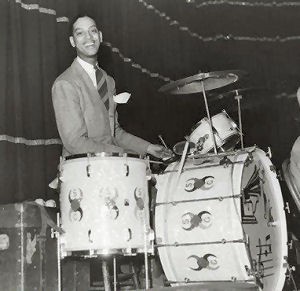 Sonny was a dapper musician who never lost sight of the fact that he wasn’t simply a drummer – he was in Show Business. He played literally hundreds of theatres with ‘The Duke’ the first one being the Palace in New York on Broadway and West 47th Street. His philosophy was that being a musician wasn’t a job it was a way of life and this way of thinking led to him appearing as himself in several Hollywood films.
Sonny was a dapper musician who never lost sight of the fact that he wasn’t simply a drummer – he was in Show Business. He played literally hundreds of theatres with ‘The Duke’ the first one being the Palace in New York on Broadway and West 47th Street. His philosophy was that being a musician wasn’t a job it was a way of life and this way of thinking led to him appearing as himself in several Hollywood films.
He wasn’t alone in dressing in a dapper way – at that time musicians frequently wore tails to play. However he was certainly the most famous player to have drums to match his suits. Rumour has it he was a development engineer for Ulysses G. Leedy in Elkhart which is probably why he managed to sit behind a massive set of Leedys worth an estimated $3000. This was at a time in the forties when a pint of milk was available for very few cents. Sonny didn’t so much have a drum set as an arsenal of drums: a couple of gongs, orchestral bells, a pair of timps, five tuned temple blocks/skulls, a cowbell or three, woodblocks, three octave vibes, a bunch of regular drums 12 x 8, 13 x 9, 16 x 14, a 6.5” ‘Broadway’ parallel action snare and even a canister throne. The timps measured 25 and 28”. As far as cymbals were concerned he used Zildjians (along with just about everybody else at the time) and had, at the very least, 12” hi hats, 14” crash and a !6” China.
Paradoxically Sonny once remarked to Smoky Dacus, the drummer who invented Western Swing: “The more drums a man has the less he is apt to play. It’s important to know when to play but it’s more important to know when not to”.
Sonny liked to personalise his drums and had either a scarab type shape between all the nutboxes on the whole set with the initial ‘S’ inside the topmost of the pincers and a ‘G’ inside the lower one. These were certainly on his Leedy set but he changed it to a capital S with a G below separated by an acute line S/G on his Leedy & Ludwig ‘Knob Tension’ set which came in regular sizes: 13 x 9, 16 x 16, 22 (or 24) x 14” and a 4.5 or 5.5” deep snare.
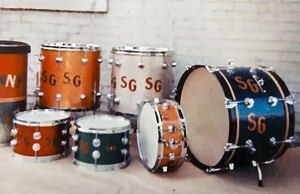 Sonny’s initials were also on the George Way drums he endorsed around 1961 when he followed Mr Way to his new company after the Knob-Tension debacle.
Sonny’s initials were also on the George Way drums he endorsed around 1961 when he followed Mr Way to his new company after the Knob-Tension debacle.
Some accounts say the logos were hand painted on the drums although the ‘dolly mixtures’ Waybest drums appear to have them inset in the sparkle in different colours.
The Waybest drums appear to be in every different size produced by George’s company and the bass drum is covered in a mirrorball effect. Incidentally, there’s a great picture of Steve Smith playing one of Sonny’s later Leedy sets on the Internet.
One of the earlier sets has a bass drum with an ‘His Master’s Voice’ dog-and-gramophone logo and a staff with a crotchet on D and another on E for, you’ve guessed it: Duke Ellington. The later front heads seemed to have a whole tune on them which has to be an Ellington one, but I haven’t managed to identify it.
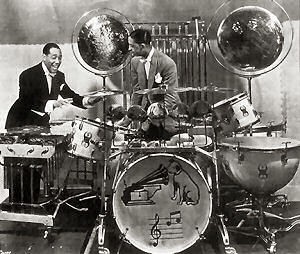 The search for all these drums has been something of a holy grail for collectors which is surprising really since they were all highly distinctive. Anyhow I know where one of the sets has ended up – Charlie Watts has one of the Leedys which he bought from Steve Maxwell in New York.
The search for all these drums has been something of a holy grail for collectors which is surprising really since they were all highly distinctive. Anyhow I know where one of the sets has ended up – Charlie Watts has one of the Leedys which he bought from Steve Maxwell in New York.
Chico Hamilton once said in an interview: “I go back to when I was 8 years old, [1929] and my mother took me to the Grauman Theatre in L.A. to see the Duke Ellington orchestra. Sonny Greer was on top of the pyramid and with more drums than a drum store. Whatever he touched music came out. He was very musical, not just a drummer like Gene Krupa or Buddy Rich, both of whom were great, but were drummers.
Duke’s son Mercer had this to say: “Sonny had a great ear and unusual reflexes.”
That said he was generally known to not be the greatest time keeper but he must have fitted rather well into Duke Ellington’s Orchestra because he played with them from 1924 until 1951. Duke Ellington said: “he wasn’t the world’s best reader of music, but the world’s best percussion reactor!” Unfortunately he suffered from something I’ve come up against in every subject for ‘Groovers and Shakers’ so far: the inability to leave the demon alcohol alone. He got into arguments with the Duke about this and left to join Johnny Hodges (who had of course played in the Ellington band too).
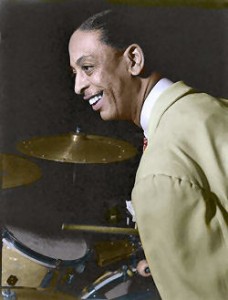 Ellington evidently booked Butch Ballard (who’d already played with Basie and Armstrong) to come along too on a Scandinavian tour just in case Sonny’s drinking got out of hand. (Sonny saw this in a different way of course saying: “Butch was added because I was burned-out doing 75 concerts in 76 days”.)
Ellington evidently booked Butch Ballard (who’d already played with Basie and Armstrong) to come along too on a Scandinavian tour just in case Sonny’s drinking got out of hand. (Sonny saw this in a different way of course saying: “Butch was added because I was burned-out doing 75 concerts in 76 days”.)
Anyhow Butch didn’t stay long, allegedly because he didn’t want to use two bass drums, so instead ‘The Duke’ hired the obvious alternative – Louie Bellson – followed eventually by Sam Woodyard – both of whom certainly did!
So Sonny put together his own trio in 1967 and in the seventies joined another with a pianist named Brooks Kerr which specialised in Duke Ellington tunes. Sort of an early tribute band you might say.
Interestingly one of Sonny’s relatives is on record saying he taught Sammy Davis junior to play the drums.
Examples of Sonny Greer’s Stuff to listen to are any version of ‘Take the A train’ although I like the one which starts in 6/8 and morphs seamlessly into a very swinging four in the bar. Otherwise look up anything else which takes your fancy: ‘Cotton tail’, ‘Rockin in Rhythm’, ‘It don’t mean a thing if it ain’t got that swing’. It’s all great!
Sonny said: “If a drummer can’t swing a band he must perforce be adjudged a failure.”
He also gave what in some circumstances may turn out to be some very good advice: “When you’re getting ready to lie, don’t smile”.
Sonny Greer died on March 23rd, 1982.
Bob Henrit
November 2013

